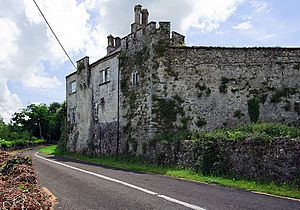Croom, County Limerick facts for kids
Quick facts for kids
Croom
Cromadh
|
|
|---|---|
|
Village
|
|

Croom Castle overlooks the River Maigue
|
|
| Country | Ireland |
| Province | Munster |
| County | County Limerick |
| Elevation | 25 m (82 ft) |
| Population
(2022)
|
1,240 |
| Irish Grid Reference | R509411 |
Croom (which is Cromadh in Irish) is a friendly village in County Limerick, Ireland. It's located right by the River Maigue. The main road, the N20, goes around the village. Croom is about 8 kilometers southeast of Adare.
Contents
History of Croom
Early Days and Vikings
Croom, or Cromadh as it was known, was once part of the Uí Fidgenti territory. This was a powerful group of people from long ago. The O'Donovans, an important family, lived here from the late 300s to the mid-1100s.
Around the year 780, a quiet place for prayer, called Dísert Óengusa, was started nearby. The River Maigue was very important for Croom. Long ago, Viking ships could travel up the river from the Shannon. This happened during the 800s and 900s. The Vikings and the O'Donovans sometimes worked together during this time.
The Burning of Croom
The first time Croom is mentioned in old records was in 1151. A powerful leader named Ruaidhrí Ua Conchobhair attacked the area. He took many cows and burned Croom. This event was part of bigger fights between different Irish groups. They were trying to control the lands where the O'Donovans lived.
The Fitzgeralds and War Cries
Later, in the early 1200s, the lands around Croom were given to the Fitzgeralds of Kildare. This was a very important family. They continued to build and manage the area until the late 1500s.
The Fitzgeralds of Kildare had a famous war cry linked to Croom. It was "Cromadh-abú," which means 'Victory to Croom!' Another branch of the Fitzgeralds, the Desmond Geraldines, had their own cry: "Seanaid-abú," linked to Shannid Castle.
Places to Visit in Croom
Croom has some interesting old places.
Croom Castle
Croom Castle was rebuilt by the Fitzgeralds. It was built on the site of an older O'Donovan fortress. The castle was fixed up again in the 1800s. In the 1700s, poets used to meet at the castle.
Ancient Ruins
West of Croom, you can find the ruins of a church from the 1400s. There is also a round tower from the 1100s. The top part of the tower is now missing.
Croom Hospital and Mills
To the east is Croom Hospital. It started in 1852 as a workhouse, which was a place for poor people to live and work. It became a hospital in 1924. Along the River Maigue, you can see an old ruined mill. There's also a newer mill built in 1788 that worked until 1927.
Civic Centre
In late 2014, a new Civic Centre opened in Croom. It has a restaurant, a library, public computers, and a hall for events.
Getting Around Croom
Croom used to have a railway station. It opened in 1862 but closed for passengers in 1934. It closed completely in 1967.
The main road, the N20, now goes around Croom. This bypass was built in 2001. Bus Éireann provides public transport. You can take a bus between Croom, Limerick, and Charleville.
Sports in Croom
Croom is home to Islanmore Stud, a place where thoroughbred horses are bred. The original house there was built for a younger brother of the Earl of Dunraven.
The local GAA club is Croom GAA. There is also a soccer club called Croom United F.C.
Schools in Croom
Croom has two schools for young people. There is a primary school called "St. Marys." There is also a secondary school named "Coláiste Chiaráin."
See also
 In Spanish: Croom (Limerick) para niños
In Spanish: Croom (Limerick) para niños



